I. What are the Basics & Fundamentals of Nucleic Acids?
We’re getting back to basics in this article! (as in, literally!!). It’s no doubt that you’ve come across this topic in some shape or form, whether you’re a molecular and cellular biology major or someone who’s just studying biology for the first time!
Before we start tackling some more complex MCAT biology/biochemical topics such as replication, transcription, and protein synthesis, we think it’d be beneficial to give you all a brief overview of the different nucleic acids involved in these processes, most notably DNA and RNA!
This is without a doubt a high yield MCAT topic (also including the study section on RNA) We highly encourage you all to have this topic as one of the first to review in regards to your MCAT prep, not just in regards to its emphasis on the MCAT, but also the amount of content overlap that also occurs. But don’t worry! We’ll take this one step at a time and will try to make the review process as easy as possible! You can do it!
II. Underlying Principles of Nucleic Acids
Before talking about the nucleic acids specifically, let’s branch a little broader and talk about their inclusions as macromolecules! The four major macromolecules include: 1) proteins, 2) carbohydrates, 3) lipids, and 4) nucleic acids.
A. Description
In other articles, you’ve seen that macromolecules are usually a molecule of repeating subunits, known as monomers. Proteins have amino acids subunits while carbohydrates contain sugar subunits (monosaccharides).
The same applies with nucleic acids! In this case, nucleic acids are composed of repeating subunits called nucleotides!
Nucleotides have three main components: 1) a pentose (5 carbon) sugar, 2) nitrogenous base (bonded to C1 carbon), and 3) phosphate (one or more bonded to C5 carbon).
I. Nucleoside v.s. Nucleotide
Before going further, however, we’ll first make the distinction between nucleosides and nucleotides as they might be a point of confusion:
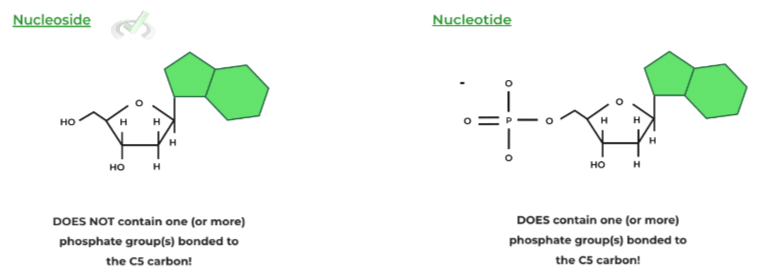
B. DNA v.s. RNA
There are 2 types of nucleic acid: DNA (deoxyribonucleic acid) and RNA (ribonucleic acid). In the context of cellular processes, there are a few structural differences between DNA and RNA.
In the cell, DNA exists as a double-stranded molecule with a deoxyribose sugar. In contrast, RNA in the cell, for the most part, exists as a single-stranded molecule and instead as a ribose sugar.
Note that here are definitely exceptions where RNA is also double stranded, as in the case of hairpin structures & viral genomes! For now, just follow this common rule
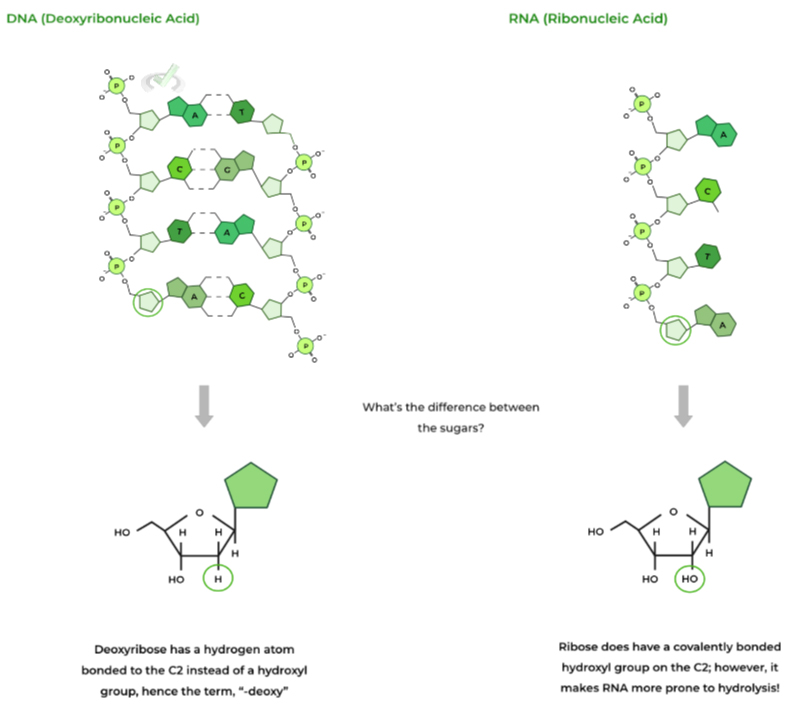
As stated above, RNA sometimes does not follow the single strand rule, as there are various exceptions.
In addition, while you may primarily think of RNA in terms of transcription, later study articles will show you other forms of RNA such as ribosomal and transfer RNA!
I. Types of Nitrogenous Bases: Purines v.s. Pyrimidines
Aside from the type of pentose sugar, the type of nitrogenous bases attached to the sugar can also be utilized to differentiate between different nucleotides.
Furthermore, the nitrogenous bases can also be further classified based on if they’re 1) purines or 2) pyrimidines.
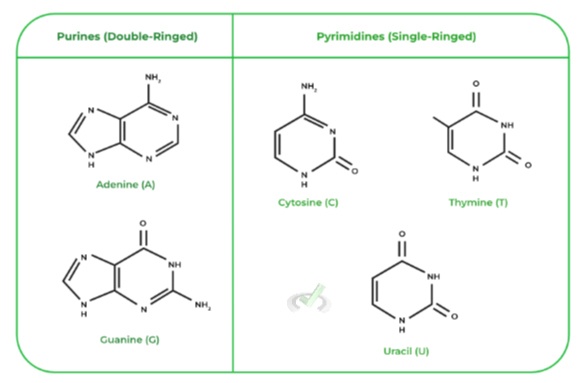
As shown in the table above, one of the main differences between purines and pyrimidines is whether they are single or double-ringed. Purines will be double-ringed while pyrimidines will be single-ringed.
These nitrogenous bases will definitely come around when discussing DNA structure and the Watson-Crick base pairing scheme!
III. Bridge/Overlap
Though you might think of DNA and RNA primarily in the context of eukaryotic cells, they definitely have other implications, especially when talking about viruses!
I. Wide Variety of Viral Genomes
This is why we mentioned above that the single strand RNA rule doesn’t always apply (but applies most of the time, nevertheless). The genomes of viruses vary widely where they can have DNA or even RNA as their viral genome.
In addition, viruses can even have either single stranded or double stranded DNA or RNA viral genomes, adding to the complexity of viruses!
We’ll talk a lot more about viruses in other study articles, but thought it’d be great to mention the importance of nucleic acid beyond eukaryotic, human cells. Take a look at some examples below!
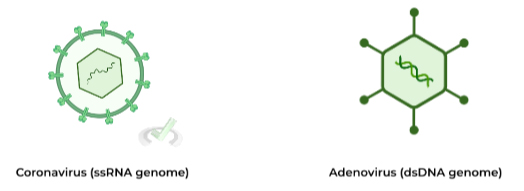
IV. Wrap Up/Key Terms
Let’s take this time to wrap up & concisely summarize what we covered above in the article!
A. Description
Similar to the other macromolecules, nucleic acids are also composed of repeating monomer subunits called nucleotides!
Nucleotides have three main components: 1) a pentose (5 carbon) sugar, 2) nitrogenous base (bonded to C1 carbon), and 3) phosphate (one or more bonded to C5 carbon).
I. Nucleoside v.s. Nucleotide
A point of emphasis to make is the distinction between nucleosides and nucleotides, as they are very similar, but still have distinct structures.
Nucleosides DO NOT have one (or more) phosphate groups attached to the pentose sugar, while nucleotides DO have one (or more) phosphate groups bonded.
B. DNA v.s. RNA
There are 2 types of nucleic acid: DNA (deoxyribonucleic acid) and RNA (ribonucleic acid). These 2 are a part of various cellular processes, including replication, transcription, etc.
Within the cell, DNA exists as a double-stranded molecule with a deoxyribose sugar while RNA generally exists as a single-stranded molecule with a ribose sugar.
Note, however, that there are cases where RNA will exist as a double stranded molecule such as in the case of hairpin structures and viral genomes!
I. Types of Nitrogenous Bases: Purines v.s. Pyrimidines
Similarly, nucleotides can also be differentiated on the basis of their nitrogenous bases! These nitrogenous bases are broken down into 2 categories: purines (double-ringed) and pyrimidines (single-ringed).
These are important when discussing the DNA’s double helix structure and Watson-Crick base pairing!
Purines consist of adenine and guanine while pyrimidines include cytosine, thymine, and uracil.
V. Practice
Take a look at these practice questions to see and solidify your understanding!
Sample Practice Question 1
Which of the following best describes the charge difference you would expect between a nucleoside and a nucleotide?
A. The nucleotide would be more negative.
B. The nucleotide would be more positive.
C. The nucleoside would be more negative.
D. Both would have the same charge.
Ans. A.
Recall that the difference between a nucleoside and a nucleotide is that a nucleotide contains one or more phosphate groups attached to the C5 carbon. Also recall that phosphate groups have a negative charge ⇒ Thus, the nucleotide should have a more negative charge.
Sample Practice Question 2
Which of the following would be the best description of the following structure depicted below?
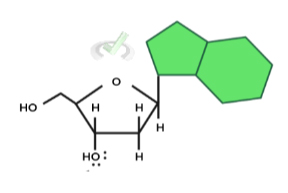
A. A nucleoside with a ribose sugar and a pyrimidine nitrogenous base.
B. A nucleoside with a deoxyribose sugar and a purine nitrogenous base.
C. A nucleotide with a ribose sugar and a purine nitrogenous base.
D. A nucleotide with a deoxyribose sugar and a purine nitrogenous base.
Ans. B.
As shown in the figure, the molecule is a nucleoside and not a nucleoside because it lacks any phosphate groups. In addition, the C2 carbon of the sugar lacks a hydroxyl group, indicating it’s a deoxyribose sugar.
Furthermore, the nitrogenous base attached to the C1 carbon is double ringed, indicating that it’s a purine base.
It’s ok if you didn’t recognize the actual name of the purine; what’s more important is that you know how to identify the difference between the double-ringed and single-ringed structure!





 To help you achieve your goal MCAT score, we take turns hosting these
To help you achieve your goal MCAT score, we take turns hosting these 
























